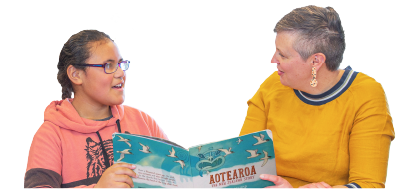Proverbs
Tapasā – Cultural competencies framework for teachers of Pacific learners
Proverbs | Alagaupu are verbal treasures | measina used in a range of Pacific contexts to make a point or statement, aligning the present with the wisdom of ancestors.
Proverbs are metaphors or expressions that allow the receiver of the proverb to make sense of matters of importance within their cultural context.
Tapasā, loosely translated, means compass or guide. Pacific ancestors successfully voyaged across oceans by reading the stars and constellations, marking the winds, and mapping the currents to make sense of the journey.
Here we use proverbs as statements of practice – how we can reflect and implement these into our teaching practice.
These proverb cards can be used to provide teachers of Pacific learners with perspectives from a worldview other than their own. This will support them as they transform thinking and practice in their interactions and relationships with Pacific learners, their families, and communities.
Gagana Samoa – connects to Turu 1
E felelei manu ae ma’au i o latou ofaga.
Birds migrate to environments where they survive and thrive.
This Samoan proverb refers to the migration of birds to habitats that enable them to survive and thrive. Their migrations require them to adapt to new surroundings. In the same way, ancestors from Pacific nations journeyed across the ocean in search of knowledge, prosperity, and growth.
Provocations:
- What do I know about my identity and culture and the ways this influences my thinking and behaviour? (Turu 1.1, p.10)
- What do I understand about the diversity within the Pacific groups in my community? (p.22)
- What cultural and prior knowledge do my Pacific learners bring to my education setting and how can I incorporate this in my practice? (p.22)
- What are my Pacific learners’ and their families’ aspirations for the future and how can I assist them to reach their goals? (p.22)
- How do I demonstrate my understanding of my Pacific learners’ cultural protocols and values? (Turu 1.13, p.11)
Te reo Maori Kuki ‘Airani – connects to Turu 2 and 3
Kia āriki au i tōku tupuranga, ka ora uatu rai tōku reo.
To embrace my heritage, my language lives on.
This Cook Islands proverb signifies the importance of embracing, celebrating, and learning about heritage. It talks of language connecting to the histories, values, and beliefs that are integral to identity.
Provocations:
- How do I incorporate the histories, stories, legends, myths, and symbols that are relevant to my Pacific learners into their learning experiences? (p.7)
- Do I understand that some of my Pacific learners may share multiple heritages and how do I support these in their educational success and achievements? (Turu 1.14, p.11)
- Do I pronounce my Pacific learners’ names and words in their language correctly? (p.7)
- Do I make an effort to learn and use words and phrases in my Pacific learners’ home languages? (p.7)
- In what ways do I invite my Pacific learners’ parents to be involved in their children/s’ learning journey? (p.7)
- What effective approaches do I use to communicate with my Pacific learners and their families? (p.7)
Vagahau Niue – connects to Turu 1, 2 and 3
Fakataufata e mafiti he gutu mo e gahua he tau lima.
When you speak with authority, make sure you follow through with actions.
This Niuean proverb expresses the idea that a person’s actions are a better indication of their character than their words.
Provocations:
- What actions am I taking to involve my Pacific learners' families in their learning journey? (p.7)
- In what ways do I lead learning and teaching that is responsive to my Pacific learners' strengths, abilities, identity, language and culture? (Turu 1.16, p.11)
- In what ways does my learning setting strategically plan for higher Pacific achievement levels? (Turu 3.18, p.15)
- How do I connect with Pacific communities and cultural leaders beyond my learning setting? (Turu 2.16, p.13)
Gagana Tokelau – connects to Turu 1 and 3
Ko toku Tokiga e mau ai toku hikohikomaga.
My culture and language consolidate my learning environment.
This Tokelauan proverb refers to the way language and culture are intrinsically connected to the learning environments children inhabit. It speaks of the importance of recognising and valuing the diverse languages and cultures children bring with them to their learning environments.
Provocations:
- In what ways do I build on the cultural and linguistic capital my Pacific learners, their fanau, and community bring? (Turu 1.10, p.11)
- How do I establish ethnic-specific and culturally safe spaces and settings for my Pacific learners? (Turu 3.13, p.15)
- Do I demonstrate approaches that consider the holistic and collective aspects of my Pacific learners, their families, and communities? (Turu 3.5, p.14)
- In what ways do I make connections to the values that are important to my Pacific learners and their families? (p.7)
Lea faka Tonga – connects to Turu 1 and 3
Fai’aki e ‘ilo ‘oua ‘e fai’aki e ifo.
Knowing, not by tasting.
This Tongan proverb signifies the importance of knowing and understanding one’s own biases, prejudices and actions of privileging. It can be seen as a caution to not act hastily without knowing a situation fully.
Provocations:
- What do I know about my teaching style that can specifically improve outcomes for Pacific learners? (p.6)
- What effective procedures and systems are in place in my setting to support and acknowledge my Pacific learners' identities, languages, and cultures? (p.6)
- Who are the groups or key leaders I need to link with within Pacific communities? (p.22)
- In what ways does my setting recognise the importance of review and improvement, and critical reflection as an important part of effective pedagogy? (p.6)
- What do I do to invite interest from non-Pacific learners and other educators in the success of my Pacific learners? (p.22)


